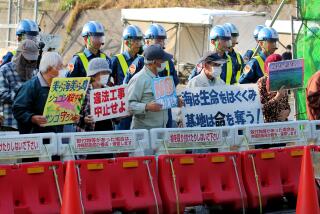U.S. Willing to Cut Troops on Okinawa : Military: Defense official says shifting of some forces to other parts of Japan is possible to ease tension after alleged rape.
- Share via
WASHINGTON — The United States signaled Friday that it would be willing to move some of the about 29,000 U.S. troops now stationed on Okinawa to other parts of Japan if it would help ease tensions on the island after last month’s rape of a schoolgirl, allegedly by U.S. servicemen.
The possible troop shift was raised by Joseph S. Nye Jr., assistant secretary of defense for international security affairs, in advance of a visit to Japan next week by Defense Secretary William J. Perry for talks with top Japanese officials. Those talks will include the Okinawa issue.
However, Nye said, the move would come only if Tokyo agreed to finance construction of new military installations elsewhere in Japan. It would be years away at the earliest, since the bases would have to be completed before the U.S. troops could move.
His suggestion was intended to portray the United States as more responsive to the Okinawans’ complaints as Perry prepares to meet with Japanese leaders.
Okinawans have complained that the island is being choked by the U.S. presence, which takes up much of its prime real estate.
Outside analysts, however, said they do not expect Japan to accept the idea, because building new military installations would be costly and because the Japanese traditionally have not been enthusiastic about keeping large numbers of U.S. troops on their home territory.
Even so, Nye’s remarks were something of a departure from previous U.S. policy, which has held that stationing the troops on Okinawa is necessary for strategic reasons.
*
The United States has responded to the rape charges by turning the suspected servicemen over to Japanese authorities and this week established new procedures for handling such cases faster.
Perry has also taken steps to reduce what he calls the U.S. “footprint” on Okinawa by agreeing to return Yomita Air Base to Japan and to relocate the military seaport at the city of Naha. The military is also exploring ways to limit live-fire exercises that now require closing a major highway.
At the same time, however, the defense secretary essentially ruled out bringing some U.S. troops home or shifting them to South Korea or other bases in Asia. He said there would be “no advantage to be gained by doing that.”
The United States has said it wants to maintain about 100,000 U.S. troops in Asia, allocated between Japan--including Okinawa--and South Korea, to help provide a U.S military presence in the region and to serve as the vanguard of an expeditionary force in case of war.
Japan and other U.S. allies have approved that U.S. presence, and President Clinton is scheduled to travel to Tokyo on Nov. 20 to sign a new joint U.S.-Japan security declaration to reaffirm the two countries’ longstanding relationship.
Nye declined to say whether the issue of relocating some of the U.S. troops now on Okinawa to other parts of Japan would be included in the Nov. 20 declaration. Perry is expected to work on the preparation of that document while in Japan.
Nye did not say where in Japan U.S. troops might be relocated. But officials here said possibilities included an installation on the island of Hokkaido and Camp Fuji, a cold-weather training base near Tokyo. Both bases would require major expansion.
*
Japan now pays the United States about $5 billion a year to help finance the cost of stationing U.S. troops on Okinawa and on the home islands--about 70% of the total tab for the operation, according to Pentagon officials.
Perry will leave Washington on Monday for a brief stop in Seattle and then head to Tokyo for two days of talks. He does not plan to visit Okinawa. On Thursday, he will fly to Seoul for discussions with South Korean leaders.
In Seoul, Perry is expected to begin talks--similar to those just completed with Japan--on what changes, if any, should be made in procedures for handling crimes committed by U.S. servicemen in South Korea. There have been several incidents of assault there recently.
The United States has maintained large numbers of troops on Okinawa since U.S. forces captured the island from Japan during World War II.
More to Read
Sign up for Essential California
The most important California stories and recommendations in your inbox every morning.
You may occasionally receive promotional content from the Los Angeles Times.










